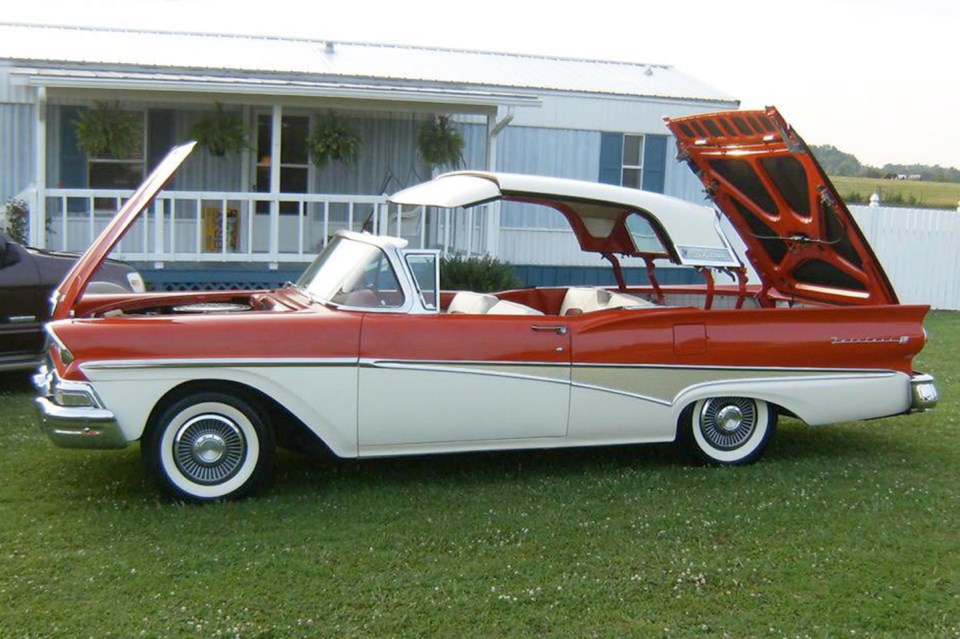True hardtop convertibles offer the best of both worlds: sporty open-air motoring for warm, balmy days, or snug, closed car comfort when the weather is inclement. This versatility is making them popular today in the marques that offer them.
Genuine hardtop convertibles should not be confused with the ersatz variety, also called pillarless hardtops, with fixed metal roofs, two-tone paint jobs and no side pillars. They gave the illusion of a convertible and gained popularity in the 1949 Cadillac Coupe de Ville, Buick Roadmaster Riviera and Oldsmobile 98 Holiday Coupe. They soon spread to lower-priced cars.
Convertibles with rigid tops that fold down are not new. The world’s first production retractable hardtop convertible was the Chrysler Airflow-influenced Peugeot 402 Eclipse introduced in the mid-1930s. The rear-hinged trunk lid opened, the electrically activated top rose up on struts and slid back into the trunk and the lid closed. It was made until 1940, with about 500 produced.
Another was the Playboy manufactured in Buffalo in the 1940s, a small coupe with a folding metal top. Fewer than 100 were built.
The best-known example came from the Ford Motor Co. — the Ford Skyliner, produced from 1957 to 1959.
The Skyliner name was used by Ford from 1954 to 1956 on a two-door sedan with a see-through, green-tinted plexiglass panel replacing the front half of the roof. The Skyliner retractable version gave the name a more realistic application.
Ford’s “retract” hardtop was originally planned for the 1956 Lincoln Continental Mark II, a reincarnation of the original classic 1940-48 Continental. But development became so costly that Ford realized the expense could not be amortized over the Continental’s small production run, so Ford got it by default.
Mainline cars were starting to encroach into the midrange market segment, so ’57 Fords were longer, lower and wider, providing the trunk width necessary to accommodate the top’s folding mechanism without major alterations.
Fords came in two wheelbases that year, 2,946 and 2,997 millimetres. The Skyliner retractible roof was on the longer-wheelbase Fairlane 500 model, but did not replace the regular Sunliner soft-top convertible.
The folding top mechanism was a real Rube Goldberg collection of motors, circuit breakers, limit switches and relays connected by about 185 metres of wire. They operated in series so if one unit failed, the operation stopped. Stays, braces, hinges and cables kept everything in place.
Engaging the retracting mechanism started an intricate series of events. The front corners of the rear-hinged deck lid were released and it pivoted up to an almost vertical position. At the same time, the rear package tray extended.
The front corners of the top were then released, and it rose and glided back. The 2,286-mm roof panel was too long to fit into the trunk, so a 250-mm front section folded and tucked under as the top made its rearward journey. After the roof settled into the trunk, the last step was closing and locking the rear deck and repositioning the package tray.
The whole process took about a minute. In the event of mechanical or electrical failure, the top could be erected manually with a crank, albeit slowly, avoiding a wet drive home.
A big disadvantage of the “retrac: was the small luggage space with the top down. Besides being small, it was difficult to access due to the rear-hinged deck lid.
To add to that inconvenience, if a flat tire occurred, the spare had to be retrieved from under the tub. When the top was up, luggage capacity was similar to the regular Ford, although the rear-hinged lid made access awkward.
A prototype Ford Skyliner was shown at the 1956 New York Auto Show and introduced to the public on April 14, 1957. U.S. president Dwight Eisenhower took delivery of the first one.
The Skyliner was a novelty showroom attraction for Ford, even overshadowing the two-seater Thunderbird, then in its last year. Despite a shortened model-year run and a price about $400 above the regular $3,000 Sunliner convertible, 20,766 Skyliners were sold. It helped Ford beat Chevrolet in sales for the first time in almost 30 years.
Novelty cars tend to lose appeal quickly, and sales of the ’58 Skyliner fell to 14,713. When the retrac sagged to 12,915 for 1959, Ford discontinued its experiment and let it slip into history.
The retractable hardtop Skyliner had the distinction of being the first mass-production, true hardtop convertible. It was an example of the “do-anything” optimism of the 1950s, making it an interesting piece of collectible automotive history.



